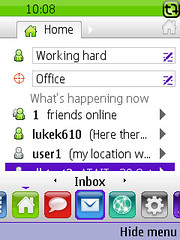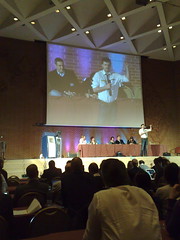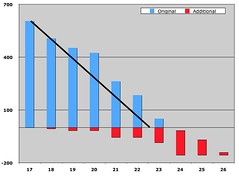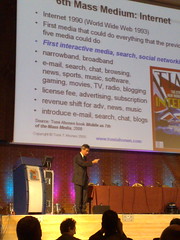Google Voice Search
November 21, 2008 | CommentsGoogle Voice Search is, frankly, amazing. Not because it works well. Most of my searches so far have been comically misinterpreted, though I note that (for research purposes only you understand) "Britney Spears" has a 100% success rate, even when I don't employ my appalling California accent.
No - to me, it's the sheer chutzpah of doing something like this, and the laser-like focus on reducing the time between deciding your wanting to know something, and Google giving it to you. I touched on this topic briefly in my talk on Monday at Future of Mobile, and Tim O'Reilly has a nice post about mobile being the lynchpin between humans and the cloud - spot on.
Can you imagine what sort of world we'll live in in 5 years time, when improvements in voice recognition (probably based around brute-force techniques rather than smart voice recognition algorithms - scale's just another tool to these guys) put an increasing percentage of our species' collective knowledge even closer? Beautiful.
Looking back at trutap
November 20, 2008 | Comments At the Future of Mobile this last Monday we launched a new version of Trutap, one of the projects that's been keeping FP busy over the last 6 months. It's been a large project, involving 11 our our folks at various points through its lifecycle and a similar number of people at Trutap.
At the Future of Mobile this last Monday we launched a new version of Trutap, one of the projects that's been keeping FP busy over the last 6 months. It's been a large project, involving 11 our our folks at various points through its lifecycle and a similar number of people at Trutap.
The brief was to rework and adapt the user interface of the original product, reusing the existing storage and communications components which we had developed in 2007 as part of version 1. Trutap wanted the new UI to support searching of their customer-base, increased emphasis on user profiles, and the addition of large numbers of third-party service providers. We wanted to push J2ME and our Cactus framework a little bit further, and experiment with a new approaches to addressing the problem of porting J2ME applications - but more on that another time.
The project started with a 1-month design effort, where we worked on some of the conceptual side of the UI (such as left-to-right navigation and a breadcrumb-trail like use of tabs) and started thinking about what components would be required to support this.
The former gave us the "big picture" which was bounced back and forth between FP and TT, iterating gently in the breeze. The latter allowed us to start making visible and worthwhile progress early. We started with a completely separate harness for UI components which let us develop and exercise them outside of the main MIDlet, testing them fully (even with edge conditions, e.g. "how does this contact look when their name is too long to show on-screen?"), before plugging them into our automated tests. As a side-effect, this enforced some good design principles: components are properly encapsulated, and we ended up reusing quite a few of them across the app.
This was the first large project which has started, run and finished since we adopted Scrum for project management at FP a year ago. It's been both a learning process, and confirmation (for us and our clients) that Scrum works "in the real world" on large complex projects... on the subject of which, if you were at my talk at the Werks a month or so back, you would have seen a diagram that looked something like this:
It's the burndown chart that we used internally to track the progress of this project. The blue bars above the X axis show the initial scope measured in estimated hours of work, whilst the red bars beneath the axis show scope added mid-project - and the black line shows the rough path of the original project plan. Each bar represents work remaining at the start of a two-week sprint. So you can see the project was originally scheduled as 12 weeks effort (sprints 17-22), the initial scope was completed in just under 14 weeks, and scope added - particularly towards the end as we iterated over the messaging section - added 6-8 weeks onto the overall timescales.
You can see that clearly some sprints went better than others (resulting in better progress); internally we tracked specific activities against these sprints, and it's no surprise that riskier activities (more technically complex ones, or those relying on third parties) tender to go slower than well-understood ones.
Only towards the end did we start sharing this chart with Trutap. I'd previously felt a bit self-conscious about filling status meetings with graphs and charts - it feels a bit geeky - but I learned a lesson here: I wished we'd done this earlier, they found it a really helpful way to represent and understand the progress we were making.
Most of the project proceeded on an incremental basis, as we gradually migrated sets of features over from the version 1 interface to the new look and feel. This proceeded section-by-section: signup and login first, then contact management, messaging, profile management, search, services, and so on. At the end of each iteration (i.e. once a fortnight), we released a version of the product to their QA team for formal testing, though we were conducting QA as part of our development too; I was pleased to hear that Trutap felt quality of releases had noticeably improved since the first version of the product last year. In the final sprints we were releasing more frequently: their QA staff had direct access to our build system and could pull off new binaries as and when they were ready.
We iterated a little on messaging, spending a sprint returning and reworking the interface once our customer had had a chance to see how the wireframes we'd all theorised about worked on a real phone; and in the final sprint of the project we had another run-through, with the Trutappers coming down to sit alongside our development team and get last-minute pre-launch changes made.
Design tended to be done "just-in-time"; sometimes we deliberately anticipated components that would be needed for the next sprints work and undertook design for them in the preceeding sprint (in a classic "design-one-sprint-ahead" model), but sometimes we were able to work a story or two ahead and keep design and development tasks in the same sprint.
I'm deliberately not writing much about lessons learned in this post; we're having a half-day retrospective with the FP and TT teams getting together next week. I'll follow up this meeting with a post here summarising the day; and there'll be another piece coming soon on our approach to porting, which I touched on at the Future of Mobile.
In the meantime: congratulations to everyone at Trutap and Future Platforms (past and present) who worked on this. I love launching :)
Future of Mobile 2008
November 18, 2008 | CommentsI really enjoyed Future of Mobile yesterday.
The day started a little sluggishly with a well-qualified panel discussing the future of mobile operating systems. I didn't feel I learned much here - revenues of the panelists businesses weren't particularly exciting, and aside from an interesting conversation around runtimes I didn't feel I learned a great deal.
For me, things really started to take off with the presentation from Doug Richard of Trutap (disclosure: they're a client of ours). Doug was talking about the rise of a middle class in the developing world that shares aspirations with the middle classes everywhere, and quietly pointed out our arrogance in assuming that it could be otherwise. I particularly liked his notion that Western operators would adopt defensive positions and hence take fewer risks (and be less innovative) than those coming out of India.
I didn't devote much attention to Matt Millar from Adobe, I'm afraid - sorry Matt, but I was doing last-minute panicking about my own presentation. I've not watched the video yet, but whilst I'd spent more time preparing than I ever have in the past (and felt the slides were reasonably polished), I made the mistake of over-planning what I was going to say. Normally I work from bullet points and just chat around them (something I'm comfortable doing) but after my hour-long overrun at the Werks talk a month or so back I tried to restrain myself by planning what I'd say in great depth. The upshot was I felt like I was working from a script, and had to keep checking where I was, staring at a screen instead of talking to the audience. Lesson learned there, but at least I managed to get my macaroons-as-analogy-for-porting slide out.
The bloggers panel was a really good format: 6 bloggers, 6 minutes each, mirroring blogging itself. Really nice to hear Vero Pepperell evangelise a human approach to communication - as an industry we ought to know that stuff, but I can't help feeling we need someone to gently beat it into us on occasion. Helen was righteous - nuff said.
A lunch, or non-lunch, followed. If there was a weak point to the day overall, I'd say it was the facilities. I heard plenty of people complain about a lack of wi-fi (though as a 3 USB dongle owner I managed OK), there was no lunch provided, and no coffee in one of the coffee breaks. Fortunately Kensington is full of restaurants and cafes, but it would've been nice to hang around in a throng during all these breaks. The auditorium itself was excellent - a lovely space, good sound, and power to most seats.
Rich Miner gave a great talk in the afternoon, filling in a bit more detail around Google and their plans, and drawing on his own history launching the Windows SPV Smartphone when he was at Orange. He gave a good if negative insight into the world of operators when he talked about product managers feeling threats from new product developments and derailing them.
Interesting also to hear about his take on mobile web apps - that they fail for reasons of network latency, lack of local storage, and access to device capabilities. Whilst you can see efforts in Android, PhoneGap and OMTP Bondi to address some of these, it's a little way from the "web apps as future of mobile" angle which I'd heard Google were adopting.
And similarly it was good to hear Rich quizzed on the topic of Android and fragmentation by David Wood (who's more qualified to talk about this than he?). Rather than espousing the rather bland "we don't think fragmentation is in the interests of the industry" line I've heard from Google before, Rich talked about the value of having a reference implementation by which to judge others; a conformance test being introduced for OEMs; and the use of challenging and popular reference apps to provide a "Lotus 1-2-3" style evaluation of an Android implementation.
Tomi Ahonen was hilarious and upbeat as usual - full of detailed and slightly threatening stats on the hold that mobile has on us, and case studies of fantastic things launched elsewhere (usually Asia). The Tohato "worlds worst war" was my favourite: purchasers of snack products fighting one another in vast virtual armies, wonderful.
 And the day finished with another panel discussion: lots of disagreement from qualified folks who've been doing this stuff for years, including two of our clients. We had some kind words said about us by Carl from Trutap and Alfie of Moblog fame - thanks guys! - and it was particularly interesting to hear the pendulum of fashion swing back towards applications, away from the mobile web. I wonder how permanent this effect, which is surely down to the iPhone App Store, will be?
And the day finished with another panel discussion: lots of disagreement from qualified folks who've been doing this stuff for years, including two of our clients. We had some kind words said about us by Carl from Trutap and Alfie of Moblog fame - thanks guys! - and it was particularly interesting to hear the pendulum of fashion swing back towards applications, away from the mobile web. I wonder how permanent this effect, which is surely down to the iPhone App Store, will be?
The evening party followed, carrying on the upbeat atmosphere :)
My slides from the day are online here. The lens-tastic Mr Ribot took video footage of the talk which you can see here, and I heard a rumour that the official footage from the event may go online some time too.
Thanks to Dominic and all the team at Carsonified for the hard work they put into the event - I know all too well from Sophie how much this takes, and they did a cracking job. And a particular yay to Mr Whatley, who stepped in as compere at the last minute and did an excellent job of keeping the audience engaged, even in those sleepy after-lunch slots ;)
Future of Mobile: What makes smartphones smart?
November 17, 2008 | CommentsWhat makes smartphones smart? Panel discussion with Simon Rockman
David Wood, Research, Symbian
Olivier Bartholiot, Purple Labs
Andy Bush, LiMo Foundation
Rich Miner, Google
James McCarthy, Microsoft
DW: We'll look back on phones of today as being rubbish in future. Very happy to see Google services running well on Symbian phones. Looking forward to collaboration; whilst competition stops us going stale, there's too much variety in the market and it's slowed us down. Symbian is a combination of old (some code is 14 years old) and new (continually renewing). Innovation is going to speed up: Symbian are removing some fragmentation from their platform (i.e. UIQ), and embracing open source.
OB: Recently recalibrated themselves as a software business. Today, the specialists in Linux on low-end devices.
AB: LiMo, a young organisation (<2yo), meant to consolidate a lot of fragmentation that was happening. First release of the platform was shown at MWC this year, second release this year. Model is that member organisations (LiMo are non-profit) contribute: about 1000 engineers working on the platform. Not a standards organisation, they're about producing real code. Use the best of open source (e.g. GTK). Their members half half a billion subscribers on their networks. They're a governance organisation: one member, one vote.
RM: Hardware OEMs and carriers don't understand software very well. This is why Apple could embarrass the industry with the release of a first-generation handset. They understand software, developers, frameworks and platform design. They built not just a handset but an ecosystem. Google fundamentally believes mobile is an important platform, and we need to get our applications out on mobile. We struggled to build MIDP apps that wouldn't require changes, app signing.
JM: To be an OS provider, you need to achieve some scale. We have over 100 mobile operator partners across the world today. All major operators sell Windows Mobile devices. MS licenses software to OEMs: the core OS is valuable.
RM: Google has no business model as regards Android: it's all open source. The aim is long-term: over time, we think that mobile is important. Our mission is to reach everyone, and we need mobile to this. Our business model is advertising, and it's important that no one entity control the mobile phone platform. Once we can deliver value to the consumer (as we did with search), we'll figure out how to deliver advertising. Android is "designed to go downmarket quickly". A lot of economies "aren't two-screen economies, these are the only devices they have".
SR: Olivier, could you talk about your business model.
... stuff about Purple Labs revenues for 2009 ...
DW: Last year we generated $300m from licensing. Symbian Foundation will be about 1/10 size of the current Symbian.
JM: HTC have been a great partner for Microsoft over the years. Samsung are grabbing UK market share in Windows Mobile terms. All our OEMs serve different markets, they all do different things.
SR: Motorola are stopping doing Symbian phones and starting to do Android phones, what do you think David?
DW: It's understandable that handset vendors don't want to rely on a single OS. In a few years there'll be less hedging of bets and some consolidation.
... panel agree that runtimes grow in importance ...
DW: Emergence of runtimes doesn't remove the need to solve fragmentation at the operating system level.
Q: What makes a smartphone smart?
DW: The ability to add features.
RM: Smartphones haven't been very smart. You could barely make calls on them when I launched them at Orange.
Q: Why is there no Apple representative on the panel?
SR: They declined to send anyone. They prefer to keep to themselves.
Future of Mobile: Tomi Ahonen
November 17, 2008 | CommentsMobile is as different from the internet as TV is different from radio.
All the concepts for TV we have today cannot migrate back to radio, though they did evolve from.
91% of mobile owners keep the phone within 3 feet, 24x7
Mobile is as addictive as smoking cigarettes. Removing mobile phones produces similar withdrawal pains as attempting to stop smoking.
Text-and-driving is more dangerous than stoned or drunk driving.
63% of people are not willing to share their phone with our spouse.
1 in 3 partners snoop inside the phone, mostly when we're in the shower. 10% of people ended relationships after this.
1 in 4 British couples sleeps apart 1 night a week because of their partners addiction to Blackberry, phones, etc.
Mass media are print, recordings, cinema, radio, television, internet, mobile.
What is print doing in a presentation with mobile? In Japan, mobile books sold ¢82m mobile books in 2006. 5/10 best-selling printed books started as mobile books. Books are written on phones using text-messaging, spelling and style.
The internet subsumed media that came before, and added interactivity. Look at Habbo Hotel for an example of a fixed internet service which raised revenue through mobile: by using billing.
Mice Love Rice: a song released for free on the internet. Sold as a ringback tone, raising $22m. Ringback tones have to be enabled by operators.
Don't try to copy the internet: create something new.
Mobile has seven advantages over internet: personal, permanently connected, always carried, built-in payment, present at creative impulse, most accurate audience, captures social context.
Carbon Diem: location-based service tracking how your mobile moves, discovering speed of movement and inferring carbon usage. Young people care more about green issues; for Tomi's generation WW3 was the threat.
Tohato: Japanese snack brand, introduced 2 new snack brands: Satan Jorquia and Habanero. Invited customers to choose a brand and fight the other brand in the "worlds worst war". Gamers joined by scanning a 2d barcode in a bag. Recruiting friends earned promotion in the army - all done via mobile, battles scheduled at 4am, with a 24-hour gaming news channel.
Hoshi-Ichi Maniac: mass participation TV format in Japan, Who Wants To Be A Millionaire, knock-out style quiz. 200k live players on the first run.
"Create services that are so amazing that the first time someone uses it, people think they're magic" - e.g. Kamera Jiten, a cameraphone translator which takes photos and translates them English to Japanese.

